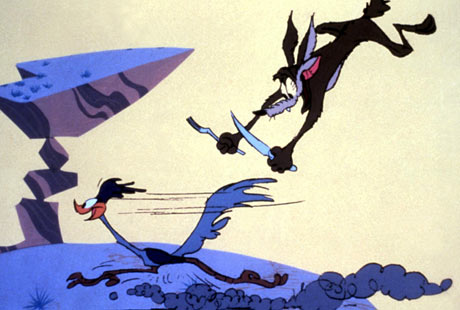This comment was published in The Guardian on 30/11/2010

Iran's Centre for Doctrinal Analysis has investigated the Road Runner cartoons and found them an insult to
Shia Muslims. Photograph: Everett Collection/Rex Features
"Your neighbour could be a spy" was the title of Mohammad Nourouzpour's article published last February in the Tehran-based Khabar Online. His article discussed how foreign intelligence agencies, especially Israel's, have been infiltrating Hamas, and how some of its members were suspected to have sold information to Israel. He warned that the same could happen to Iran.
The attacks on two Iranian nuclear scientists – which killed one of them on Monday – are bound to increase the level of paranoia in Iran's intelligence agencies. One has to wonder what new horizons such paranoia could reach, because the Iranian government is already paranoid. Not only humans, but these days birds are suspects too.
A prime example were the suspicious "big birds, the size of Eagles", which were spotted flying over the village of Kamo, close to Iran's uranium enrichment facility at Natanz. Quoting "informed sources", publications such as Asr Iran wrote that these big birds were seen to be carrying "listening devices like mobile phones, which were attached to the chest". They were also reported to have had aerials attached to the heads, as well as "devices to receive and send intelligence".
To some of us, such a report may conjure up images of Sesame Street, with its famous big bird on a spoof spy mission, struggling under the punishing weight of kilos of intelligence equipment, with antennae sticking out of every orifice. But to the Iranian government, these are all serious threats. With advances made in the world of intelligence gathering, everything is viewed as a possible suspect.
The Iranian government wasted no time in blaming Israel for the assassination attempts. "Most experts who follow Middle East politics and Mossad history would agree," wrote Yossi Melman, an expert in Israeli intelligence matters.
There is also the possibility that the hit was carried out by the regime itself, after finding out that the scientists were connected to opposition parties, such as the Green movement. Killing them in such a manner would enable the regime to absolve itself of any responsibility, as it would enable it to place the blame on foreign intelligence agencies. It is thought that this indeed was the case in the assassination of Iranian nuclear scientist Masoud Ali-Mohammdi in January this year.
However, that scenario seems less likely in yesterday's assassination, as no evidence has emerged linking them to any opposition movement, nor has the opposition said anything.
Monday's events are going to have domestic implications. The organisation that stands to lose is the Revolutionary Guards' counterintelligence arm (Sazeman-e Hefazate Ettela'at, meaning Organisation for the Safekeeping of Intelligence). It is the job of this organisation to thwart attempts by foreign intelligence agencies to collect intelligence on Iran's nuclear programme and cause damage to it, through operations such as viruses and assassinations. Judging by this week's events, as well as the Stuxnet attack, which even Ahmadinejad admitted had caused damage, this organisation has been failing in its task.
However, the person who deserves blame more than anyone else for such failings is Supreme Leader Ali Khamenei himself. It was he who made the war against "soft threats" a priority for Iran's intelligence and security apparatus. Since then, such organisations, and their public backers such as Hassan Abbasi's Centre for Doctrinal Analysis, have spent millions of dollars researching cartoons such as Coyote and the Road Runner as part of an effort to uncover western plots to overthrow the regime.
And to make sure he is worth his budget, Abbasi does not disappoint. The Road Runner is one such culprit. Why? "Because in the cartoon, the Coyote uses a drum, like the one Shia use in mourning ceremonies." He interprets it as an insult against Shia Muslims. He also concludes that because some cactus plants in the cartoon are shaped like the male anatomy, the west is giving Muslims "the bird" (not the type that has been sighted flying the Natanz enrichment plant).
Instead of spending money on establishing the Coyote's anti-Shia credentials, the regime's intelligence apparatus should come up with answers about what happened on Monday. As well as questions about bikers who are reported to have carried out the assassination, there is also the mysterious case of a Peugeot 206, which the police chased and fired at but were unable to catch, soon after the first attack that took place at 7.45am in front of Shahid Beheshti university (believed to be the attempt against Fereydoon Abbasi).
Nothing has been said about this vehicle. Was it part of the assassination team? Did it play the part of backup? Or was it just an ordinary bystander who got nervous and ran away?
Nineteenth-century military theorist Karl von Clausewitz wrote that war is an extension of politics, but by other means. Khamenei is involved in an intelligence war against the west. His problem is the fact that the political foundations of his regime are rotting. And when you have decaying politics, that impacts the application of war and, specifically in Iran's case, the ability to defend its nuclear programme.
The longer the regime's decreasing legitimacy and the ensuing infighting continues, the more risks he will expose his regime to, including its nuclear programme.
No comments:
Post a Comment